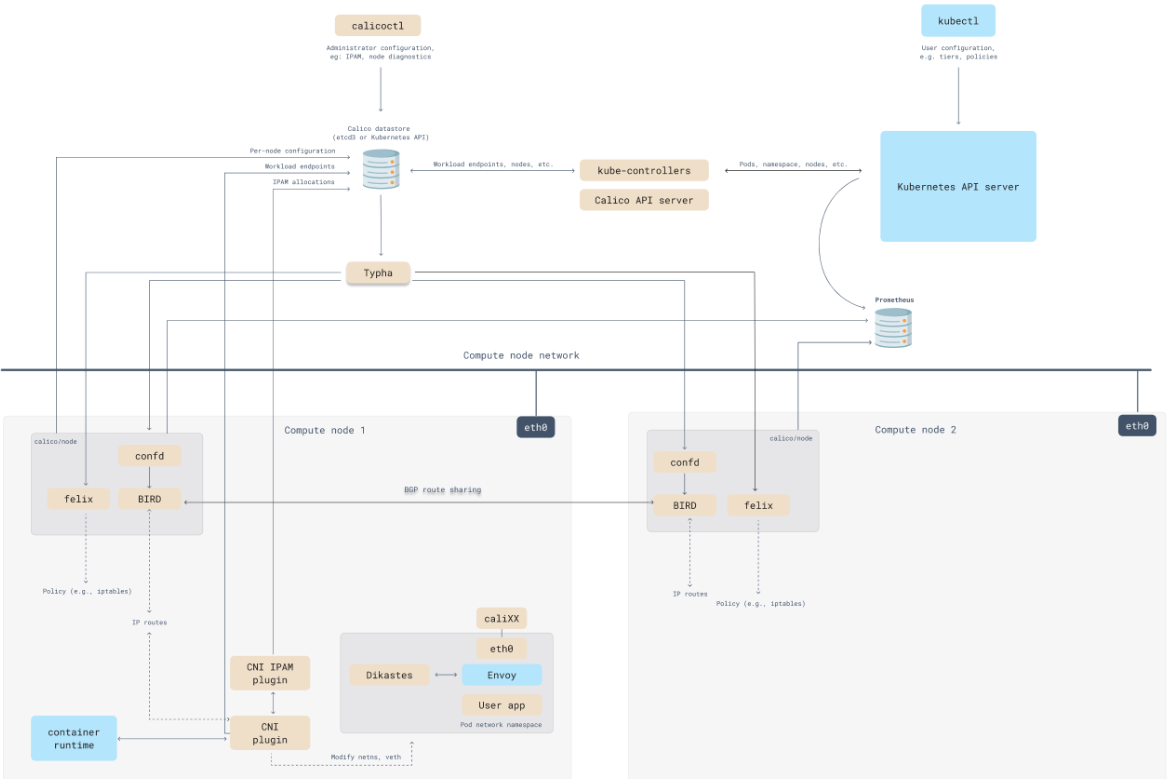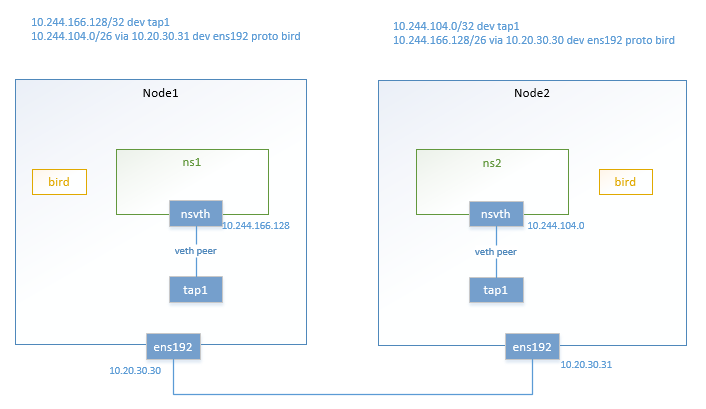背景
Calico支持多种网络模式,包括vxlan/ipip/bgp,其中vxlan和ipip属于overlay类型,在嵌套部署模式比较通用,但网络性能相对bgp会低一些。这主要是由于bgp模式下没有数据报文的封包和解包操作
本文会将calico中bgp相关的操作流程抽离,通过demo的方式来介绍calico中bgp网络的实现
架构
calico架构

Calico作为一种常用的Kubernetes网络插件,使用BGP协议对各节点的容器网络进行路由交换。Calico中使用的软件BGP方案是Bird
BIRD(BIRD Internet Routing Daemon)是一款可运行在Linux和其他类Unix系统上的路由软件,它实现了多种路由协议,比如BGP、OSPF、RIP等。
BIRD会在内存中维护许多路由表,路由表根据不同的协议,通过与各种“其他事物”交换路由信息,来更新路由规则。这里说的“其他事物”可能是其他的路由表,也可能是外部的路由器,还可以是内核的某些API
demo架构

实现
模拟calico cni创建和配置网卡的操作
node1节点
1
2
3
4
5
6
7
8
9
10
11
12
13
14
15
16
17
18
# 创建namespace和虚拟网卡
ip netns add ns1
ip link add tap1 type veth peer name nsvth netns ns1
ip link set tap1 up
ip netns exec ns1 ip link set lo up
ip netns exec ns1 ip link set nsvth up
# 配置路由和IP地址
ip netns exec ns1 ip addr add 10.244.166.128/24 dev nsvth
ip r add 10.244.166.128/32 dev tap1
ip netns exec ns1 ip r add 169.254.1.1 dev nsvth
ip netns exec ns1 ip r add default via 169.254.1.1 dev nsvth
# 配置neigh
ip link set address ee:ee:ee:ee:ee:ee dev tap1
ip netns exec ns1 ip neigh add 169.254.1.1 dev nsvth lladdr ee:ee:ee:ee:ee:ee
node2节点
1
2
3
4
5
6
7
8
9
10
11
12
13
14
15
16
17
18
# 创建namespace和虚拟网卡
ip netns add ns1
ip link add tap1 type veth peer name nsvth netns ns1
ip link set tap1 up
ip netns exec ns1 ip link set lo up
ip netns exec ns1 ip link set nsvth up
# 配置路由和IP地址
ip netns exec ns1 ip addr add 10.244.104.0/24 dev nsvth
ip r add 10.244.104.0/32 dev tap1
ip netns exec ns1 ip r add 169.254.1.1 dev nsvth
ip netns exec ns1 ip r add default via 169.254.1.1 dev nsvth
# 配置neigh
ip link set address ee:ee:ee:ee:ee:ee dev tap1
ip netns exec ns1 ip neigh add 169.254.1.1 dev nsvth lladdr ee:ee:ee:ee:ee:ee
每个节点启动bird 启动一个容器并获取内部的bird二进制文件,镜像使用calico/node:v3.11.1
1
2
3
docker run --name calico-temp -d calico/node:v3.11.1 sleep 3600
docker cp calico-temp:/usr/bin/bird /usr/bin
docker rm -f calico-temp
创建bird.cfg配置
1
2
3
4
5
6
7
8
9
10
11
12
13
14
15
16
17
18
19
20
21
22
23
24
25
26
27
28
29
30
31
32
33
34
35
36
37
38
39
40
41
42
43
44
45
46
47
48
49
50
51
52
53
54
55
56
57
58
59
60
61
62
63
64
65
66
67
68
69
70
71
72
73
74
75
76
77
78
79
80
81
82
83
84
85
86
function apply_communities ()
{
}
# Generated by confd
include "bird_aggr.cfg";
include "bird_ipam.cfg";
router id 10.20.30.30;
# Configure synchronization between routing tables and kernel.
protocol kernel {
learn; # Learn all alien routes from the kernel
persist; # Don't remove routes on bird shutdown
scan time 2; # Scan kernel routing table every 2 seconds
import all;
export filter calico_kernel_programming; # Default is export none
graceful restart; # Turn on graceful restart to reduce potential flaps in
# routes when reloading BIRD configuration. With a full
# automatic mesh, there is no way to prevent BGP from
# flapping since multiple nodes update their BGP
# configuration at the same time, GR is not guaranteed to
# work correctly in this scenario.
merge paths on; # Allow export multipath routes (ECMP)
}
# Watch interface up/down events.
protocol device {
debug { states };
scan time 2; # Scan interfaces every 2 seconds
}
protocol direct {
debug { states };
interface -"cali*", -"kube-ipvs*", "*"; # Exclude cali* and kube-ipvs* but
# include everything else. In
# IPVS-mode, kube-proxy creates a
# kube-ipvs0 interface. We exclude
# kube-ipvs0 because this interface
# gets an address for every in use
# cluster IP. We use static routes
# for when we legitimately want to
# export cluster IPs.
}
# Template for all BGP clients
template bgp bgp_template {
debug { states };
description "Connection to BGP peer";
local as 64512;
multihop;
gateway recursive; # This should be the default, but just in case.
import all; # Import all routes, since we don't know what the upstream
# topology is and therefore have to trust the ToR/RR.
export filter calico_export_to_bgp_peers; # Only want to export routes for workloads.
add paths on;
graceful restart; # See comment in kernel section about graceful restart.
connect delay time 2;
connect retry time 5;
error wait time 5,30;
}
# ------------- Node-to-node mesh -------------
# For peer /host/node1/ip_addr_v4
# Skipping ourselves (10.20.30.30)
# For peer /host/node2/ip_addr_v4
protocol bgp Mesh_10_20_30_31 from bgp_template {
neighbor 10.20.30.31 as 64512;
source address 10.20.30.30; # The local address we use for the TCP connection
#passive on; # Mesh is unidirectional, peer will connect to us.
}
# For peer /host/node3/ip_addr_v4
#protocol bgp Mesh_10_20_30_32 from bgp_template {
# neighbor 10.20.30.32 as 64512;
# source address 10.20.30.30; # The local address we use for the TCP connection
# passive on; # Mesh is unidirectional, peer will connect to us.
#}
# ------------- Global peers -------------
# No global peers configured.
# ------------- Node-specific peers -------------
# No node-specific peers configured.
创建bird_ipam.cfg配置
1
2
3
4
5
6
7
8
9
10
11
12
13
14
15
16
17
18
19
20
21
22
# Generated by confd
filter calico_export_to_bgp_peers {
# filter code terminates when it calls `accept;` or `reject;`, call apply_communities() before calico_aggr()
apply_communities();
calico_aggr();
if ( net ~ 10.244.0.0/16 ) then {
accept;
}
reject;
}
filter calico_kernel_programming {
if ( net ~ 10.244.0.0/16 ) then {
krt_tunnel = "";
accept;
}
accept;
}
创建bird_aggr.cfg配置
1
2
3
4
5
6
7
8
9
10
11
12
13
14
15
# Generated by confd
protocol static {
# IP blocks for this host.
route 10.244.166.128/26 blackhole;
}
# Aggregation of routes on this host; export the block, nothing beneath it.
function calico_aggr ()
{
# Block 10.244.166.128/26 is confirmed
if ( net = 10.244.166.128/26 ) then { accept; }
if ( net ~ 10.244.166.128/26 ) then { reject; }
}
运行bird进程
1
bird -R -s ./bird.ctl -d -c ./bird.cfg
此时在node1/node2节点会发现分别多了一条到对方的路由规则
1
2
3
4
5
6
7
8
9
10
11
12
13
14
15
16
17
18
19
[root@node1 bird]# ip r
default via 179.20.23.1 dev ens160 proto static metric 100
10.20.30.0/24 dev ens192 proto kernel scope link src 10.20.30.30 metric 101
10.244.104.0/26 via 10.20.30.31 dev ens192 proto bird
10.244.166.128 dev tap1 scope link
blackhole 10.244.166.128/26 proto bird
172.17.0.0/16 dev docker0 proto kernel scope link src 172.17.0.1 linkdown
179.20.23.0/24 dev ens160 proto kernel scope link src 179.20.23.30 metric 100
[root@node2 ~]# ip r
default via 179.20.23.1 dev ens160 proto static metric 100
10.20.30.0/24 dev ens192 proto kernel scope link src 10.20.30.31 metric 101
10.244.104.0 dev tap1 scope link
blackhole 10.244.104.0/26 proto bird
10.244.104.1 dev cali6fa4fc0f157 scope link
10.244.104.2 dev calif2ac964c43c scope link
10.244.166.128/26 via 10.20.30.30 dev ens192 proto bird
172.17.0.0/16 dev docker0 proto kernel scope link src 172.17.0.1 linkdown
179.20.23.0/24 dev ens160 proto kernel scope link src 179.20.23.31 metric 100
从node1的ns1中ping node2的ns1 ip
1
2
3
4
5
6
7
8
9
10
11
12
13
14
15
16
17
18
19
20
21
22
23
[root@node1 bird]# ip netns exec ns ip a
1: lo: <LOOPBACK,UP,LOWER_UP> mtu 65536 qdisc noqueue state UNKNOWN group default qlen 1000
link/loopback 00:00:00:00:00:00 brd 00:00:00:00:00:00
inet 127.0.0.1/8 scope host lo
valid_lft forever preferred_lft forever
inet6 ::1/128 scope host
valid_lft forever preferred_lft forever
2: nsvth@if9: <BROADCAST,MULTICAST,UP,LOWER_UP> mtu 1500 qdisc noqueue state UP group default qlen 1000
link/ether 2e:be:65:26:b3:0d brd ff:ff:ff:ff:ff:ff link-netnsid 0
inet 10.244.166.128/24 scope global nsvth
valid_lft forever preferred_lft forever
inet6 fe80::2cbe:65ff:fe26:b30d/64 scope link
valid_lft forever preferred_lft forever
[root@node1 bird]# ip netns exec ns ping 10.244.104.0
PING 10.244.104.0 (10.244.104.0) 56(84) bytes of data.
64 bytes from 10.244.104.0: icmp_seq=1 ttl=62 time=0.299 ms
64 bytes from 10.244.104.0: icmp_seq=2 ttl=62 time=0.356 ms
64 bytes from 10.244.104.0: icmp_seq=3 ttl=62 time=0.314 ms
^C
--- 10.244.104.0 ping statistics ---
3 packets transmitted, 3 received, 0% packet loss, time 2033ms
rtt min/avg/max/mdev = 0.299/0.323/0.356/0.024 ms
参考
- bird手册:The BIRD Internet Routing Daemon Project (network.cz)